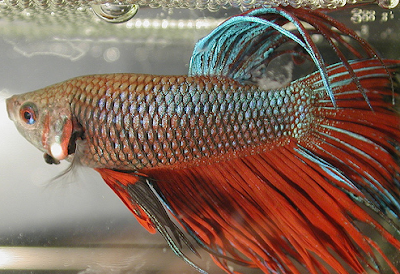 Sooner or later every child wants a pet. But what if your grandchild has an allergy that prevents him from having a furred or feathered friend? Or what if she lives in a strictly enforced no-pets zone or can't have one that has to be exercised or groomed? Not to worry! There's a hypo-allergenic pet that never needs to be walked, is quiet, doesn't bite, doesn't require a costly set up and is easy to care for. What is this perfect pet? It's the beautiful betta fish.
Sooner or later every child wants a pet. But what if your grandchild has an allergy that prevents him from having a furred or feathered friend? Or what if she lives in a strictly enforced no-pets zone or can't have one that has to be exercised or groomed? Not to worry! There's a hypo-allergenic pet that never needs to be walked, is quiet, doesn't bite, doesn't require a costly set up and is easy to care for. What is this perfect pet? It's the beautiful betta fish.Female bettas aren't as showy as the males and they can be harder to find. The more attractive male bettas have long flowing fins and tails and make very interesting pets. If properly cared for, bettas can live to be 2 or 3 years old. And since most are already adults when purchased, your betta's life span could depend on how old the fish was when you bought it.
Bettas come in a rainbow of lovely colors – blue, green, red, purple, aqua and even white – so your grandchild may be able to find a fish in his favorite color.
You should never put two male bettas (also called Siamese fighting fish) in the same container. They will fight to the death. To see a betta display aggressive posture, hold a mirror up to the bowl. The fish will flare its fins and gills at the reflection. This behavior makes it look bigger and more threatening to an intruder.
Bettas do well in small containers, and though you often see them for sale in tiny cups, these cups shouldn't be used as the betta's permanent home. A nice, large goldfish bowl works well and one that holds at least a gallon of water would be more than adequate for a single betta.
Keep the bowl in an area of the home where the temperature is stable. A range of around 70 degrees to 75 degrees is fine, and as long as the room doesn't get too cold, a heater in the bowl won't be necessary. Just be careful not to place the bowl where the sun will shine directly on it, and don't set it too close to heating or cooling vents.
Keep an eye on the water. When it starts to look a little cloudy, it's time to do a water change. Help your grandchild carefully dip the fish out and set it aside in a cup of bowl water. Dump the old water and lightly rinse the gravel and accessories, and then refill the bowl with water that is about the same temperature as the discarded water. It's a good idea to use water that has aged for a few hours or to which you have added a couple of drops of chlorine neutralizer. When your grandchild has finished cleaning and refilling the bowl, gently release the betta back into its home.
You can also change about a quarter of the water twice a week, if you wish. Top the bowl off with fresh water, or use bottled drinking water. If you choose this method, show your grandchild how to use a small fish net to dip any debris out of the bottom of the bowl.
There may sometimes be a lot of bubbles clustered at the top of the bowl, but these are nothing to worry about. The betta is just building bubble nests. An interesting note: Bettas are labrynth fish, which means they are able to breathe air!
Ask the pet store personnel to recommend a good betta food. Teach your grandchild how to sprinkle a small amount of food in the bowl a couple of times a day. The betta will learn to come to the top of the bowl and eat the food as soon as it hits the water.
Always be careful to feed only as much food as the fish will eat in a few minutes. Too much uneaten food will cloud the water faster and could make the betta sick.
Your grandchild will probably enjoy picking out a few cute ornaments to dress up the fish bowl. And she might even want to buy aquarium gravel to match the fish's color! Just make sure there are no sharp edges on anything and that the betta will still have plenty of room to swim.
An aquatic snail will help keep the bowl clean and will be interesting to watch. A small plant also would be a nice addition to the bowl. Ask the store employee to help your grandchild choose.